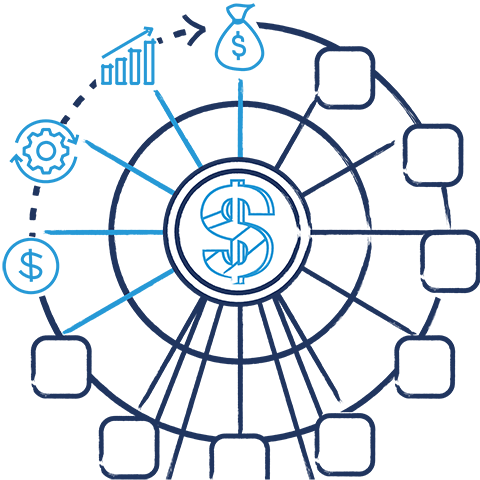
How to forecast and manage cash flow
Well-designed cash flow management makes the difference between entrepreneurial success and failure. It is a crucial metric for shareholders and an important basis for decisions concerning the future of a business.
What is cash flow?
Cash flow describes the movements of cash or cash equivalent (such as short-term commitments that can easily be transferred back into cash) in and out of a business. Cash entering the organization, e.g. return on investment or from interest, is called cash inflows, and cash leaving the organization, e.g. through expenses, is called cash outflows. Being able to generate positive cash flows and maximize long-term free cash flow (FCF) is crucial for creating shareholder value.
Why pay attention to cash flow?
Cash accounting refers to an accounting method where payments and expenses are recorded when cash enters or leaves the business. This is in contrast with accrual accounting, which reports revenue and expenses when it is earned, or occurs instead of when payment is received or paid. The distinction between the two types of accounting is earnings versus cash. Earnings are not cash – they occur when a sale or expense is made. Cash can occur at a different time entirely.
It is important to understand this distinction when coordinating a business’s finances. A negative cash flow occurs when outflows are higher than inflows. It is possible for an organization to have significant earnings and profit in a given quarter but, due to a delay in payment, still be in a negative cash flow position. The goods and services provided still have a cost if the customer has not yet paid. This lag in cash may force an organization into a position where it needs to use debt to cover normal business expenses.
Types of cash flow
There are four types of cash flow: free, operating, investing, and financing.
- Cash flow from operations (CFO) – this, also called operating cash flow, is the measure of cash flows directly linked to the production and sale of goods and services during normal business operations.
- Cash flow from investing (CFI) – this measures the amount of cash received and spent on investment-related activities in a specific time window.
- Cash flow from financing (CFF) – this reports the net flow of cash involved in the funding of an organization. It shows the cash inflows from equity and debt, and cash outflows from dividends paid and the repurchase of debt and equity.
- Free Cash Flow (FCF) – an organization’s ability to generate value is determined by its ability to generate long-term FCF. This is the cash generated by an organization from its normal business operations after capital expenditure (CapEx) has been deducted.
Understanding corporate financial statements
The balance sheet, income statement, and cash flow statement are the three critical parts of any corporate financial statement.
Balance sheet
An organization’s assets, liabilities, and shareholders’ equity are recorded on its balance sheet. This is essentially a snapshot of what an organization owns and owes, as well as its investors’ equity. Assets are everything that an organization owns. Liabilities are what is owed, such as debt, and equity is the amount of money invested by shareholders.
An isolated balance sheet provides no insight into an organization’s financial trends. However, by analyzing changes in various line items over time, it is possible to gain some valuable insights. The balance sheet can enable an investor to measure an organization’s financial well-being by using it to derive a few key metrics: working capital, debt-equity ratio, and quick/acid-test ratio.
Income statement
The income statement, often called the profit and loss statement or the statement of revenue and expenditure, is a financial report that focuses on an organization’s revenues and expenses during a certain time period. The income statement is concerned with four key elements: revenue, expenses, gains, and losses. The process involves first calculating the net income and, subsequently, the earnings per share (EPS). To summarize, it provides an accounting of how the organization’s net revenue is converted into net earnings.
Cash flow statement
A cash flow statement (CFS) is a financial statement that shows how well an organization generates cash to pay its debt obligations, cover its operational costs, and make capital expenditures. The CFS includes all cash inflows, both internal and external, as well as all outflows associated with business activities and investments during a specific quarter.
How to analyze cash flows
A CFS has three sections related to operations (CFO), investing (CFI), and financing (CFF). To analyze an organization’s cash flow, investors need to examine the following metrics: FCF, as defined earlier, and operating cash flow/net sales.
Operating cash flow/net sales
The ratio of an organization’s net operating cash flow and its net sales tells investors the average amount of money generated per sale. While higher is usually better, investors should use historic data to inform the performance of this metric. Positive cash flow is an indicator that an organization is in a promising position. A continuous positive net cash flow position allows companies to avoid excessive leveraging, pay dividends, survive market downturns, and expand the business.
Planning business cash flow
A cash flow plan is a monthly prediction of an organization’s cash flow to ensure that it stays solvent. The following steps are crucial for a successful cash flow plan:
- Identifying the organization’s goals and funds required to achieve them
- Projection of future spending and revenue based on previous statistics
- Consideration of seasonal variations while projecting future costs
- Itemizing expenses that are related to outgoing cash flow in this period
- Calculating cash inflows, including financing and potential investments
Completing the projections and itemizing each expense enables a monthly cash flow projection to be created. The information from this projection can help to build a cash flow strategy to address possible miscalculations before they expand into larger difficulties. A negative cash flow position indicates a need to look for financing or other forms of cash income to restore the cash flow balance.
Accelerate your planning
With Excel-based cash flow software, Jedox enables organizations to plan, measure, and report on cash flow effortlessly. With Jedox, plans are easily adaptable to changing business conditions. Cash flow can be monitored in real time and plans changed accordingly.
Request a demo to learn more about how Jedox can accelerate cash flow planning.





